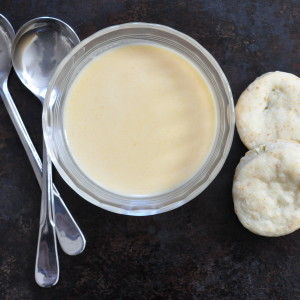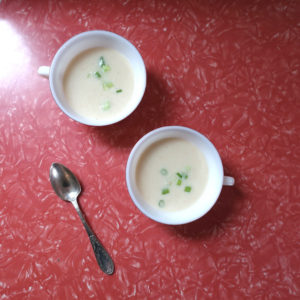Criques de Gramat: French Potato Pancakes
This post began innocently enough: what could be bad about potato pancakes with ham and cheese, via Southwest France? Then, being me, I began poking around in my cookbooks for a little historical background, only to have the entire enormous subject known as “Southwest France And The Potato” nearly engulf me. Given John is still recovering from what his doctors euphemistically term “a procedure”–more accurately, surgery–I really can’t do the full Paula Wolfert on criques de gamat. Frankly, it’s all I can do to sit down and write. Which is unfortunate, as criques look damned interesting. But just getting to eat them isn’t so bad, either.

Suffice to say, criques de gamat are one way the peasants of Southwest France, faced with plenty of potatoes, a little pork, and perhaps some cheese, made incredibly tasty food despite often dire poverty. Read the recipe and realize criques de gamat has a large family tree including tartiflette, aligot, and innumerable gratins.

According to Elisabeth Luard, writing in The Old World Kitchen, criques, also called matefaims, or in English, “kill-hunger,” are prepared in Provence during harvest time. They are considered fast food, meant to fuel hungry farm workers. As few of us are headed out to prune the Armagnac vines after eating, it must be admitted that criques are not diet food. So, caveat cooktor: it is difficult not to wolf criques, matefaims, kill-hungers, or whatever you wish to call them, hot from the pan.
Some nitty gritty. I offer no dipping sauce because 1. it isn’t traditional, and 2. criques are so rich you won’t need or want one. Accompany these with a green salad and you’ll be content.
I’m also leery of offering a prep time. While not difficult, a fifteen minute special this ain’t. The time lies in prepping the potatoes and grating. The frying goes pretty quickly. But your speed will be impacted by equipment, whether you clean as you go, and your personal cooking style.
Finally, this is a recipe that can easily go feral on you. Shreds of potato fly everywhere. Potato starch drips on the floor, your shirt, your shoes. The potato turns a bilious shade of pink, which I share here so you don’t freak when it happens to you:

You might question whether the recipe will ever come together. You might in fact want to throw out the entire soppy bowl and cry. To spare you, I’ve done my best to create a streamlined recipe that includes a stopping point where you can clean up, take a deep breath, and have a nice glass of rosé.

Traditional criques recipes call for graters. As I cannot think of faster way to insane pain, I suggest the food processor. You want old, mealy potatoes, and you want them dry, dry, dry. And no matter how well you squeeze them during prep, they’ll still exude moisture. So instead of freaking out, dab at that puddle and call it good.

Why does this picture make me think of the Beatles? Because I’ve lost my mind? See? Now you are, too.
Criques de Gamat: French Potato Pancakes with Ham and Cheese
adapted–just–from Diana Henry’s Plenty
yield: approximately 15 3-inch diameter pancakes
4 large russet potatoes; approximately 2 pounds
8 ounces hard cheese (see note)
4 ounces cooked ham, sliced into small pieces, ready in a small bowl or dish
4 garlic cloves, peeled
3 tablespoons parsley
2 large eggs, cracked into a small bowl
salt and pepper
flour, for dredging
canola or peanut oil, for frying
While criques obviously can be made using a hand grater, I made them using a food processor with the grating attachment.
Begin with the potatoes.
Line your largest mixing bowl with two non-linting dishtowels. Leave in the sink, so if you spill potatoes, it’s easy to clean up.
Peel the potatoes and slice them to fit into feed tube of the processor. Shred potatoes in processor with grating blade. Upend them into the dishtowel-lined bowl. Wrap well to squeeze moisture out. Leave to dry.
Place a large clean bowl beside the food processor.
You don’t need to clean the processor for the next step. Carefully put work bowl and shredder blade back on the base. Now shred the cheese, garlic, and parsley. My machine balked at the final addition of parsley, so I just chopped it lightly.
Carefully unpend the cheese, garlic, and parsley into the clean bowl.
You now have the cheesy bowl, the potato bowl, the eggs, and the ham.
This is a good time to clean the processor, before the potato starch dries to stone. I find an old toothbrush effective for cleaning the grater blade and all those tiny processor parts. Clean up the kitchen to make space. Drink some wine. It’s 5 o’clock somewhere.
Return to your potatoes. Carefully squeeze potatoes, then remove the wet dishtowels. The potatoes will be a horrible shade of pink. Don’t worry. It will vanish in cooking. Slide them into the bowl as best you can.
Add the contents of cheesy bowl, eggs, and ham. Mix with a wooden spoon or your clean hands. Salt and pepper generously.
You can fry these in your favorite cast iron or non-stick pan. I use two non-stick pans. Over medium high heat, pour just enough oil to coat the bottom of the pan(s).
Spread some flour on a plate, platter, or large dish. Pick up a handful of the potato mixture. It will be wet; squeeze the mixture to get excess water out. Flour just one side. Criques don’t have to be perfectly round or beautiful. They may seem like they don’t want to hold together. Don’t worry, they will in cooking.
Add as many criques to your pan as it will hold without crowding. Cook 3-4 minutes per side, until nicely browned but not burning. Flip and cook another 3-4 minutes. You may need to give it an additional couple minutes if not cooked through. Taste to be sure. It’s a tough job.
You will likely need to add oil.
Repeat until batter is used up.
As you cook, you’ll notice liquid pooling in the bottom of the batter bowl. I use kitchen toweling and dab this up.
Criques may be kept warm in a low oven. They also reheat well, should you have leftovers.
Notes: Some criques recipes call for Gruyère cheese, while others simply say “hard flavorful cheese.” Some recipe have no cheese at all. I used a mix of Gouda and Manchego because I had them in the fridge. They worked beautifully.
We ate these for dinner with salad, then decimated the remains for breakfast.





